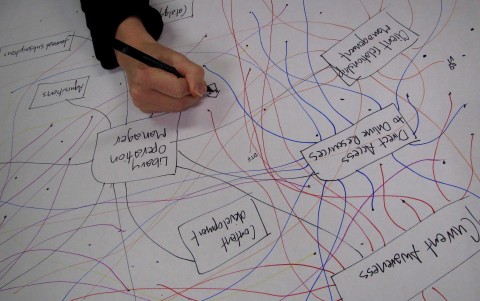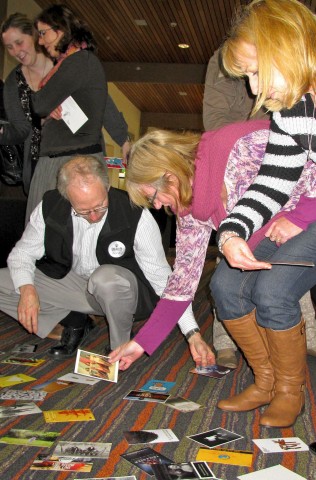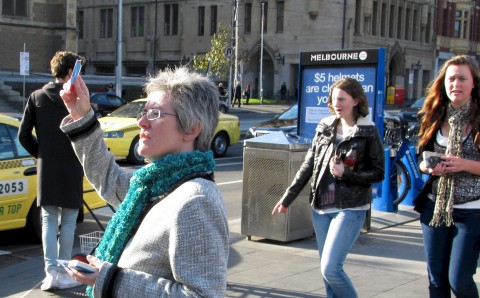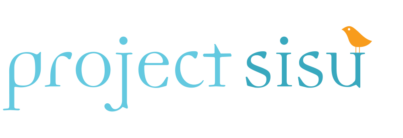Ways of seeing
What’s older – using words or reading pictures? It’s the latter, of course, as advertisers well know. Our visual circuitry is old, really old. Neuroscience has now filled in the gaps that Madmen have intuitively exploited. The development of your brain started first with facial recognition long before words made any sense. And while we rely on language for most things in our adult lives, there are times when words alone can fail us. Mostly, it’s those times when complex feelings are involved, or inchoate needs.
I’ve worked with groups grappling with change for over thirty years. Long before market researchers made it fashionable, I’ve used visual methods to unearth elusive insights, incipient ideas, and rich associations.
Here are some things I’ve learned along the way.
let the sun shine in
Solutions can nearly always be found somewhere inside the problem. However, the anxiety of not knowing the answer often pushes people to scurry for a quick solution before they’ve fully explored the terrain. I’ve found that metaphors, photos and stories offer the best place to start when looking for the keys. Easy to say; not so easy to execute.

Upside down org chart
Here is an example.Two banks were merging, which meant lots of systems integration, culture change and staff redundancies. The finance and payroll teams had a big job on their hands, and the joint project team was stuck. I asked the team to imagine their problem as an object or animal. In small teams, they would draw the object/animal, let it speak about what it observed about the ‘problem’, and what ideas it had about how to solve it.
There was stony, deathly, interminable silence. Finally, the project leader said: “Annie, you don’t seem to understand: We are accountants; we deal in numbers not stories. And we are definitely, categorically NOT artists.” I appreciate that, I replied, “but if your numbers were giving you the answers you need in this situation, you wouldn’t have asked me in to help. Maybe you could trust my expertise for a few minutes.” Reluctantly, they picked up the pens and paper. Time passed, no one stopped drawing. Lots of animated conversations erupted around the room. Then, to my astonishment, these unassuming accountants and administrators, sitting on the floor in a pedestrian seminar room, came up with ‘artworks’ that radiated humour and vitality. They left with valuable insights too, and pride in being able to do something that seemed impossible. It’s difficult to make direct causal links between an exercise like this and the final decisions a team takes away, but what I can say is that opening the aperture lets more light in. That light lifts the energy, tone and range of options available. People are less landlocked and more intellectually adventurous. When it comes to complex decision-making, more light always helps.
be resourceful

Using postcards to explore questions
A few years ago I started collecting free postcards. You name it – art galleries, cafés, performance spaces, train stations – wherever I went my eye would alight on them. I’ve amassed quite a lot now and found them to be versatile conversation starters. As part of our research project into the cultural benefits of public libraries, on behalf the State Library of Victoria, I’ve been running workshops with public library users and staff in regional areas across Victoria. I ask library users to pick one or two postcards to describe what the library means to them. Everyone gets to have a say, and what they say is amazing. It’s alive, bright, spacious, visionary, democratic, responsive, and a thing of delicate beauty, people have said. Sure, we’re gathering quantitative information as well, and conducting all sorts of interviews and forums. But if I could bottle up the things people say and the way they say them, I probably wouldn’t have to write a report. Sometimes people get very attached to the card they’ve chosen and because I’ve picked them up for free I’m happy to give them away. People love the postcards and are now sourcing them for me. It’s free, easy and fun. Car maker Henry Ford once said: “If I had asked people what they wanted, I would just have invented a faster horse.” Maybe Henry needed some postcards and new ways to ask the question.
change the pattern
I was once asked to run a problem solving session with a bunch of burly men from a steel mill. Team leaders for an outfit providing protection services to the steelworks, many of them had been steel workers themselves in the past. It was an industrial town; they were practical, no-nonsense men. I said I would only do it if we could hold the day-long session in the local art gallery. I thought this might be a bridge too far but, no, it was desperation, I think, that drove them to agree on the venue. The team was struggling with how to handle a number of personnel problems in a highly unionised workplace. Not one of them had ever visited their local art gallery before, and they were visibly uncomfortable about being there. As we got closer to the heart of the problem I stopped the conversation and said, “I want you to spend the next 20 minutes walking around the gallery until you find a painting or sculpture that speaks to you about this problem and offers some insight into a solution.” The biggest, burliest, most alpha member of the team thundered back at me: “Twenty minutes!!! How can you expect us to spend ALL THAT TIME wandering around this place when we’ve got important things to discuss.” I almost backed down then. I could feel myself shaking inside. But I held my ground: “Yes, I do expect you to do it, and I know you can do it. Let’s meet up at 11.20 in the Australian painters’ gallery at the rear of the building.” I turned up at the appointed time; no one was there. For a second I thought they had all taken off, but then they started arriving in dribs and drabs, their faces transformed. This place is amazing, one said. I’m going to bring the kids here on the weekend, another quipped. As for the task at hand? They were all drop-dead eloquent in their descriptions of what they had chosen and why. From then on, the session went swimmingly and we arrived at some practical solutions they could all embrace.

Out and about with Sisu Cards
If you want fresh perspectives, changing the pattern can help: if you always have sit-down meetings, alternate them by inserting stand up meetings only (keep them short); if meetings take place in the same-old dreary room, relocate to the park; if you’re trying to map out a complex system and flowcharts are doing your head in, use different visual methods to shift the energy (as I describe in Moments of M).
It’s not hard, it just means challenging convention. Having useful tools can help. Check out the Sisu Bento Box for ideas, or give me a call.


